Watching the comings and goings of various parts of the car market, as every good Autocar reader so keenly does, grants a unique perspective on the importance of good timing for a would-be buyer.
This is a cyclical business, and whatever part of it interests you will have fertile periods of renewal and fallow stretches of hibernation.
You can find our advice on any particular class’s top entrants in the back of this magazine on any given Wednesday, of course – and any of our segment champions will be worth your money whenever you happen to be ready to spend it. But it’s also undeniably true that right now is a particularly good time to buy an SUV, for example, and that last year was a fine one for family hatchbacks. Fresh arrivals always increase choice and renew competitive forces, which can only ever be good news for the likes of you and me.

And there’s definitely some spring-time blooming happening right now in the market for mid-sized executive saloons. Last autumn, Jaguar introduced an all-new Jaguar XF. Now comes Mercedes-Benz’s latest E-Class – which is either the fifth or 10th-generation version, depending on whether or not you count the ones that came along before Mercedes starting officially calling them ‘E-Class’ in 1993. So if you’d had close to £40,000 to spend in this segment in April 2015, you’d have read quite different advice in the back pages of our magazine from that which you’re about to read in April 2016. Moreover, by keeping your powder dry for 12 months, your chances of getting a bad deal or ending up with a car that’s at all second-rate are greatly reduced.
So here we are, where the action is, ready to jump. The office fleet manager is on hold. What we need to know is how much the new ‘W213’ E-Class changes a picture that still feels familiar, the current executive saloon incumbent champion, the Jaguar XF, having only been installed on its throne when the car went through the road test mill back in December. We’re pitting the bigselling four-cylinder diesel versions against each other, because those are the ones you’re most likely to buy – so it’s 192bhp E 220 d versus 187bhp BMW 520d and 178bhp XF 2.0d. What chance another change of executive class leadership in the space of five months?
You might think you know what to expect from an E-Class: heft, gravitas, material substance, occupant space, cabin isolation, ride refinement, some high-end cabin equipment, perhaps. But a classleading four-cylinder diesel engine? Pull the other one. Well, believe it. The new E 220 d is the first Mercedes to benefit from Stuttgart’s newgeneration, aluminium-blocked ‘OM 654’ 2.0-litre diesel motor, which is due to be rolled out across all of its model lines to replace the venerable ‘OM 651’ 2.1-litre lump that has been overdue for retirement for a while. Smaller and significantly lighter than the engine it replaces, the new 2.0-litre motor has low-friction cylinder liners, an offset crankshaft and repositioned balancer shafts. It apparently walks EU6 emissions requirements, designed as much for the EU’s forthcoming WLTP test cycle. And in the nose of the E 220 d – a car that has grown as part of its latest regeneration and still isn’t the lightest cab on the class rank, in spite of its hybrid aluminium and high-strength steel construction – it makes for outstanding manufacturer claims on peak power, 0-62mph acceleration, NEDC fuel economy and CO2 emissions.
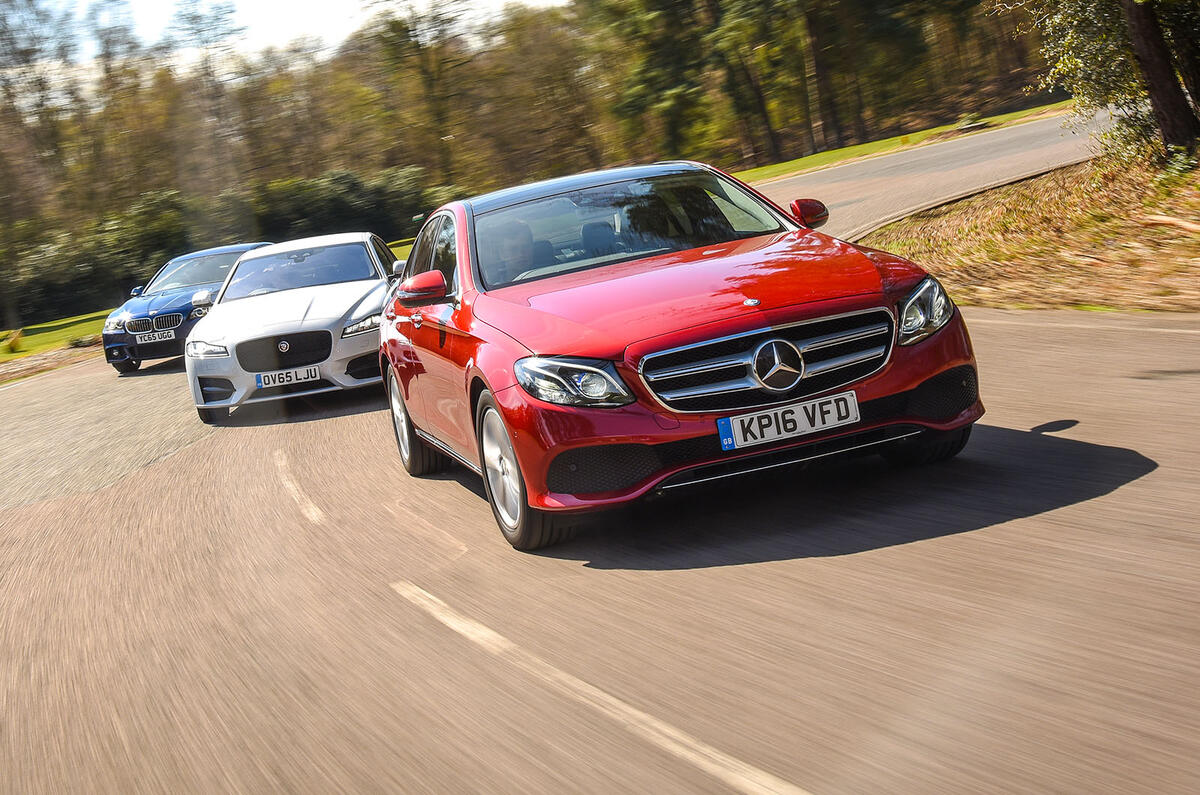
But before we get into the differences made to the car’s driving experience, a pause to take in the pertinent details of the spaces in which these three cars invite you to spend such a significant portion of your working week. Our cars are within 50mm of each other on overall length and are even more closely matched on wheelbase. So predictably, they offer similar quantities of cabin space and carrying capacity. The XF is, by a whisker, the tightest car of the three for larger adults travelling in the back seats, but it’s still easily roomy enough for most. More surprising, the new E-Class isn’t the most commodious car of the trio. That distinction goes narrowly to the car that has been on sale for five years, the 5 Series, which has back seat cushions that are longer and more supportive than the E-Class’s and notably more head room in both rows.
But those objective differences do little to communicate the stark differences in ambient character between the E-Class, 5 Series and XF, which should serve as a suitable preamble for the dynamic differences to follow. You sit high in the new E-Class, aware of a higher vantage point than you could get in either of its rivals, with a good view out in all directions, a good sense for the corners of the car and a pleasing impression of space around your extremities. In the XF, you’re hunkered down more intimately, with a high-rise centre console on one side and a higher-rising door card on the other, the steering wheel and instruments closer to your down-theroad eye line. The 5 Series splits the difference: spacious and convenient, with BMW’s brilliant sports seats offering all the comfort, adjustability and support you’ll ever need.
In isolation, the Jaguar’s standards on material quality, fit and finish seem fine; the sophistication of its instrumentation and infotainment likewise. But park your XF next to a new E-Class and you’ll realise what you could have won. The Mercedes’ interior is in a different league from the Jaguar’s. It’s more rich and expensive than the BMW’s, too.
The E-Class comes, as an option, with twin 12.3in ‘double-display’ LCD screens that stretch across most of the fascia, backlit and appearing to float in front of the roll-top dashboard. It has a newgeneration Comand infotainment system that’s vastly easier to navigate than what went before, as a result of touch-sensitive pads positioned on each side spoke of the steering wheel that make it easier to select the function you want without taking your hands from a quarter to three.
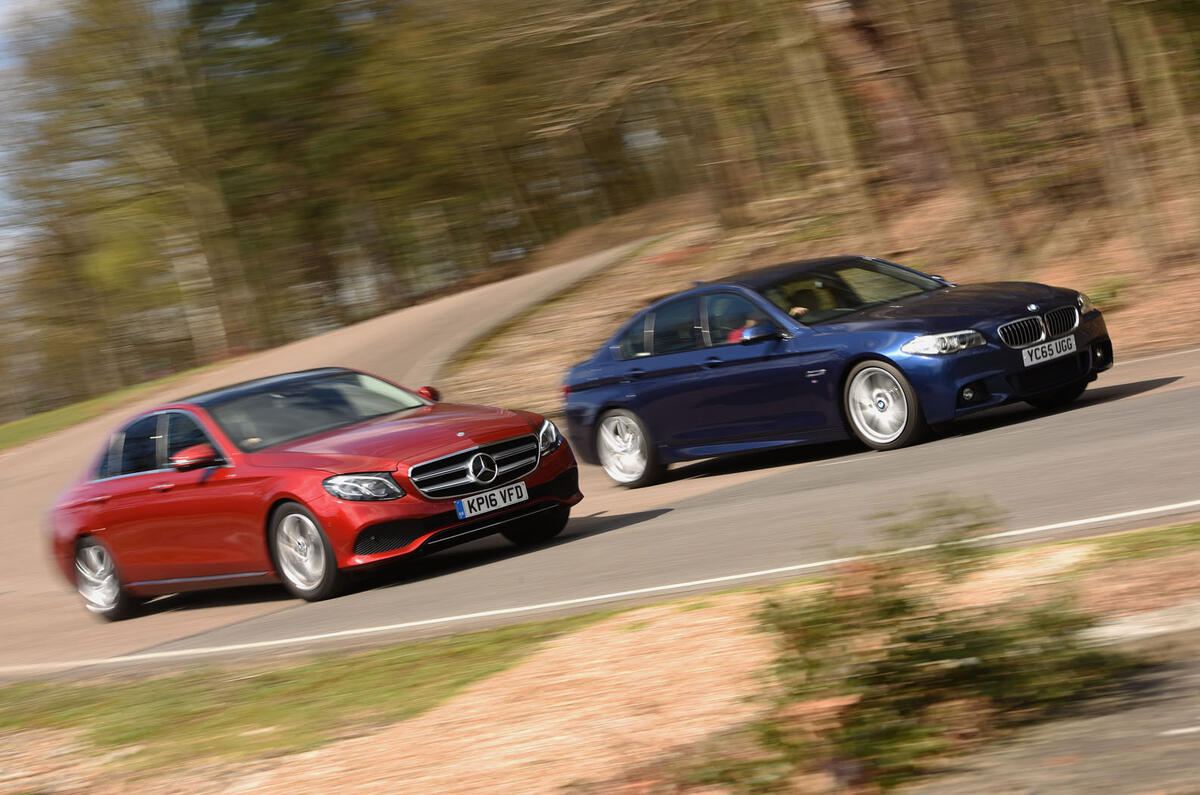
The E-Class’s switchgear and trim look expensive and feel it too. Its 23-speaker Burmester premium audio system sounds supreme. The car has wireless smartphone charging and outstanding active safety and active cruise control convenience systems. If you like to see, hear and feel what your premium-brand cash is buying in what’s directly in front of you and wrapped around you mile by mile, the E-Class just offers you more – and the 5 Series make a better fist of competing with it than the XF.
Time to turn the form book upside down, then. Mercedes’ 2.0-litre engine idles sufficiently quietly and smoothly to teach Jaguar Land Rover a thing or two about what a new four-pot diesel should sound and feel like these days. It has transformed the E-Class from one of the least mechanically refined executive saloons in the class into one of the most well mannered.
Neither the XF nor the 5 Series is very far behind the E-Class in this respect, though – and it’s to the aid of the stragglers that whichever four-cylinder oil-burner you find in a car of this size and type, it’s still unlikely to feel special. These are the workaday grunt powerplants of the executive saloon world, originally designed for economy and costeffectiveness – and then made the default choice by half-baked CO2- derived tax legislation and a buying public more interested in kit count than distinguishing mechanical richness and performance.
So although our test instruments confirm that the E 220 d is the quietest, smoothest, fastestaccelerating and most economical car here, those advantages will only do so much for it. Against the clock, the Mercedes accelerates from 30mph to 70mph through the gears 1.5sec quicker than the Jaguar and 0.9sec ahead of the BMW. For our True MPG testers, the E 220 d returned a 56.8mpg average and the best of its rivals was the 520d, at 48.5mpg. The E 220 d is almost 2dB quieter than the XF at a 70mph cruise. All will be meaningful advantages for the car in realworld use – and yet none is enough to lift the impression of the car’s powertrain far above the ordinary.

You look elsewhere, therefore, to find a really convincing selling point for any of these cars in how they conduct themselves on the road – and the first you find is the XF’s handling precision and dynamism. But before we delve deeper into this, we should note a trim level difference here. Whereas the 520d and XF 2.0d submitted for this exercise were in M Sport and R-Sport guise respectively, with the wheels, tyres and suspension tunes configured to appeal to keener drivers, the E 220 d came as an entrylevel SE model, which means 17in alloy wheels, higher-profile tyres and standard ‘comfort’ suspension settings. E-Class buyers will be able to choose a lowered, passively damped suspension set-up as an alternative, or a lowered adaptively damped sports suspension, or heightadjustable Airmatic air suspension – and all ought to better prepare the car for battle with rivals that, we already know, set a high bar for driver appeal.
And yet if any new E-Class, save perhaps the Mercedes-AMG version, can approach either the equivalent XF or 5 Series on dynamic verve, we’ll be very surprised. The Mercedes seems geared for an entirely different agenda from the Jaguar’s and, to a lesser but still telling extent, the BMW’s, too. While the XF constructs its ride comfort from its subtle but progressive close damper control, acknowledging that its driver wants to feel at once connected to and cushioned from the road surface, the E-Class commits wholeheartedly to long-wave compliance and ride isolation. Everything the Benz does is done in order to add so little to the fatigue of the daily grind as to make almost no difference, so it answers the Jaguar’s perfect steering weight and fine directional responses with lightness at the rim and a stabilising sneeze zone around dead centre.
As you add steering angle in the E 220 d, the wheel weights up and gains directness in an attempt to convince you that it can be athletic through the corners. But it’s a token gesture. Where the perfect balance and taut poise of the XF make it feel lithe and lively, the E-Class lacks the simple grip and composure to go with it. The softness of the Mercedes’ responses is at odds with the eventual speed of the steering off-centre, often forcing the car into understeer before it has even settled on its outside contact patches. And as it begins to heave and porpoise gently on its springs through dips and over bumps, even a seven-tenths crosscountry pace is enough to convince you that the E-Class isn’t a car that likes to be hurried along.
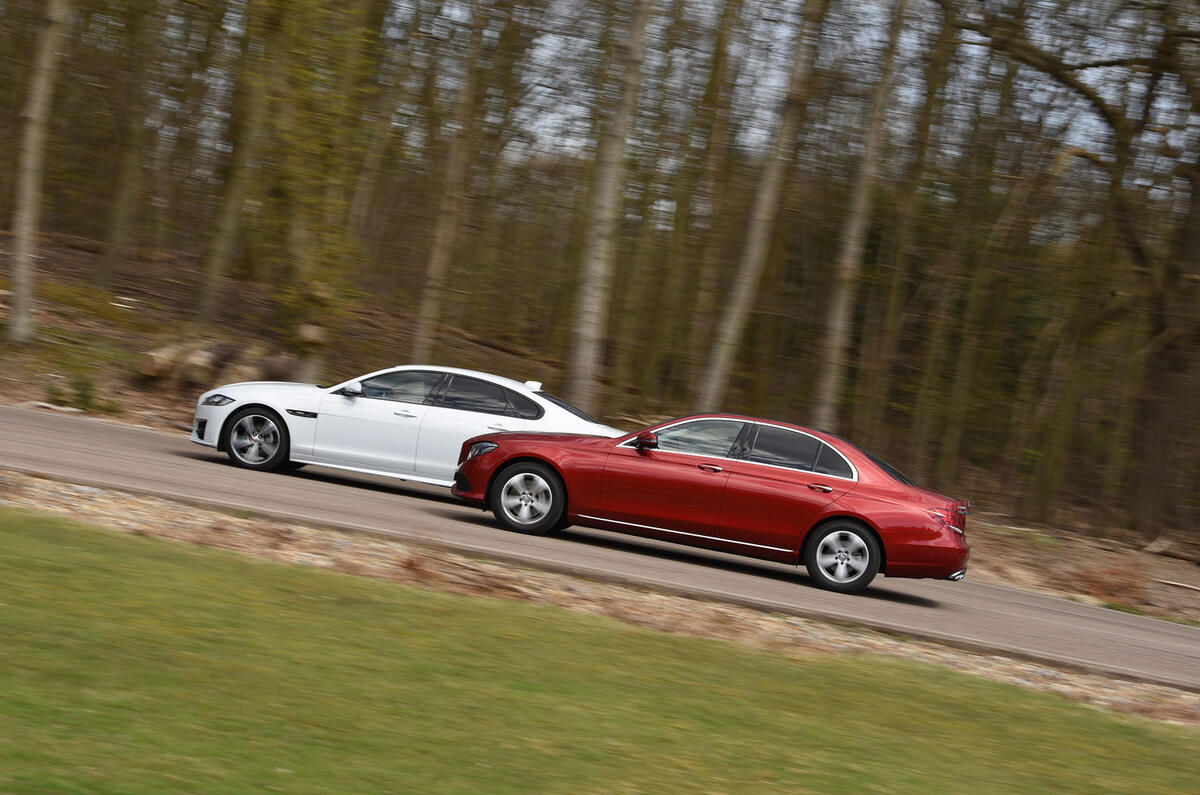
The 520d’s achievement, next to rivals that seem at polar opposites of the dynamic spectrum, is its breadth of ability. On optional adaptive M Sport suspension, the BMW can approach the sybaritic gentility of the Merc and the accuracy and involvement of the Jag. The 5 Series is still the executive option for any mood or occasion, still competitive in its fifth year on sale, still in possession of the keenest-feeling engine and cleverest automatic gearbox here. It’s still a hard car to see beyond.
But, for the likes of us at least, not quite hard enough. Although every group test needs a verdict, it seems particularly harsh to rank these cars, because each one thoroughly deserves its following. So this is at least as much an order of preference, as I’d expect interested drivers and readers of Autocar to exercise it, as of merit. Although there are still disappointing cars in the mid-sized executive market even in 2016, there isn’t one in this test.
No one could take much issue with what the new E 220 d does; it’s what it is that relegates the car to last place in our final order. It’s functional and understated, supremely well built and kitted out, and outstandingly refined, relatively pacey and easy to drive, thanks to that new engine. But it’s also one-dimensional – gloriously so, in fact. Really, this is a luxury saloon running against pseudo-sporting four-doors. Those who describe it as a mini S-Class fundamentally misunderstand the E-Class’s character and role. There’s nothing grand or assuming here. There is only a deliciously old-fashioned sense of reserve and contentment in service.
In the 520d you get more: plenty of sporting edge twinned with huge everyday ownership appeal, which is enough for second place here. And in the XF 2.0d you get accommodation, equipment, quality, refinement and performance levels that pass muster – and abundant driver appeal that makes them worth the trade. It’s as simple as that
Jaguar XF 2.0 R-Sport AT
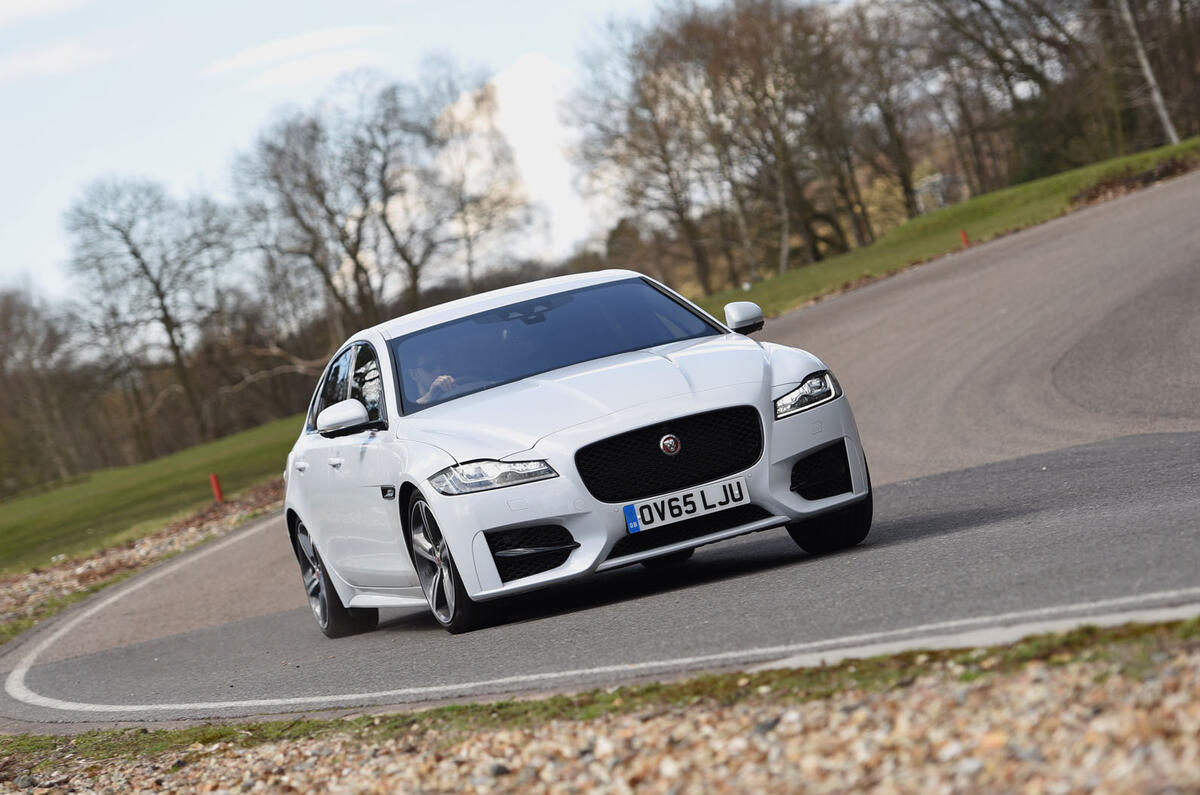
Rating 4.5/5; Price £36,850; 0-62mph 8.1sec (claimed); Top speed 136mph; Economy 65.7mpg; CO2 emissions 114g/km; Kerb weight 1595kg; Engine layout 4 cyls, 1999cc, diesel; Installation Front, longitudinal, RWD; Power 178bhp at 4000rpm; Torque 317lb ft at 1750rpm
BMW 520d M Sport auto

Rating 4/5; Price £36,865; 0-62mph 7.9sec (claimed); Top speed 147mph; Economy 62.8mpg; CO2 emissions 119g/km; Kerb weight 1695kg; Engine layout 4 cyls, 1995cc, diesel; Installation Front, longitudinal, RWD; Power 187bhp at 4000rpm; Torque 295lb ft at 1750rpm
Mercedes-Benz E220 d SE
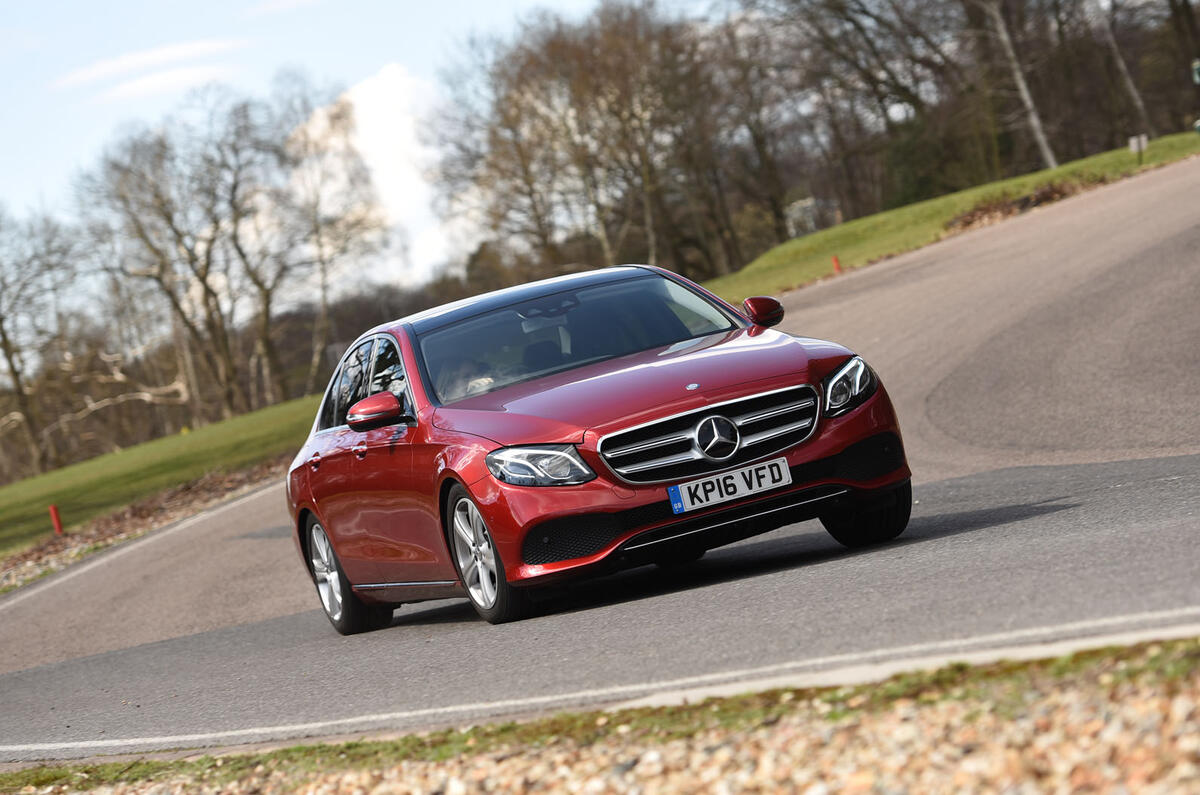
Rating 4/5; Price £35,935; 0-62mph 7.3sec (claimed); Top speed 149mph; Economy 72.2mpg; CO2 emissions 102g/km; Kerb weight 1680kg; Engine layout 4 cyls, 1950cc, diesel; Installation Front, longitudinal, RWD; Power 192bhp at 3800rpm; Torque 295lb ft at 1600-2400rpm

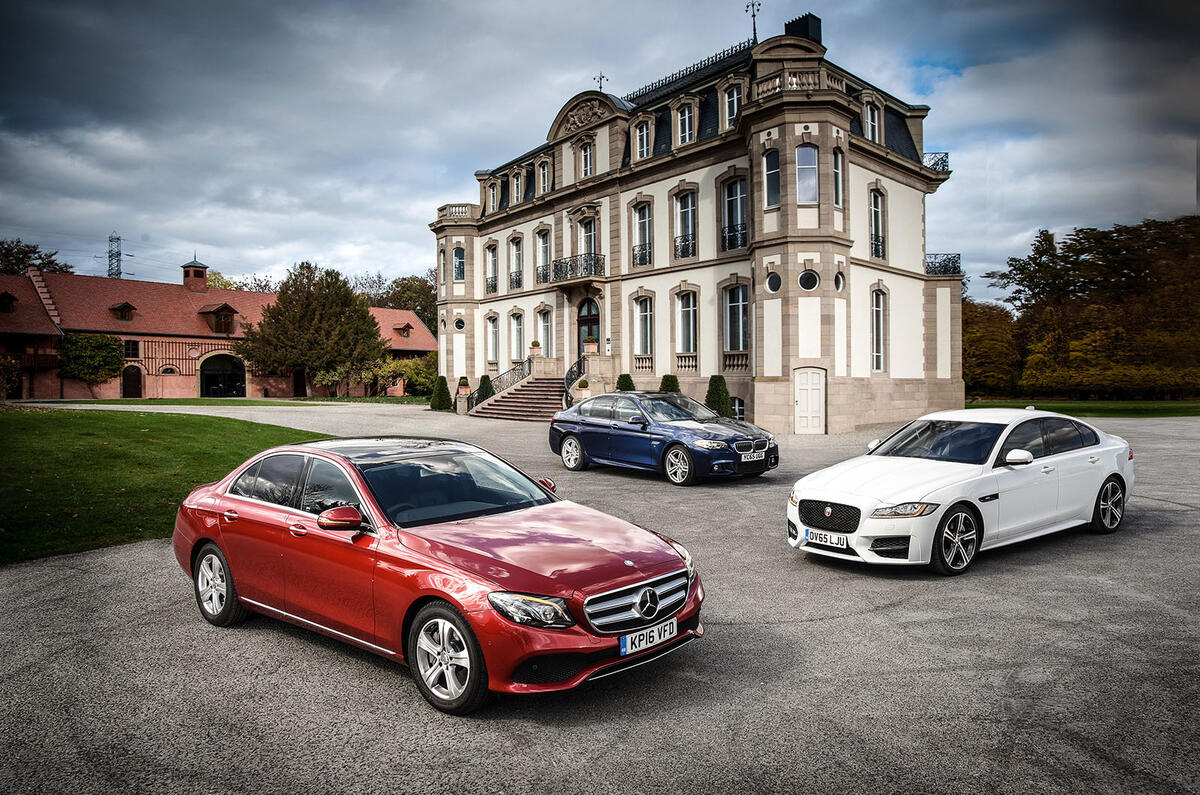
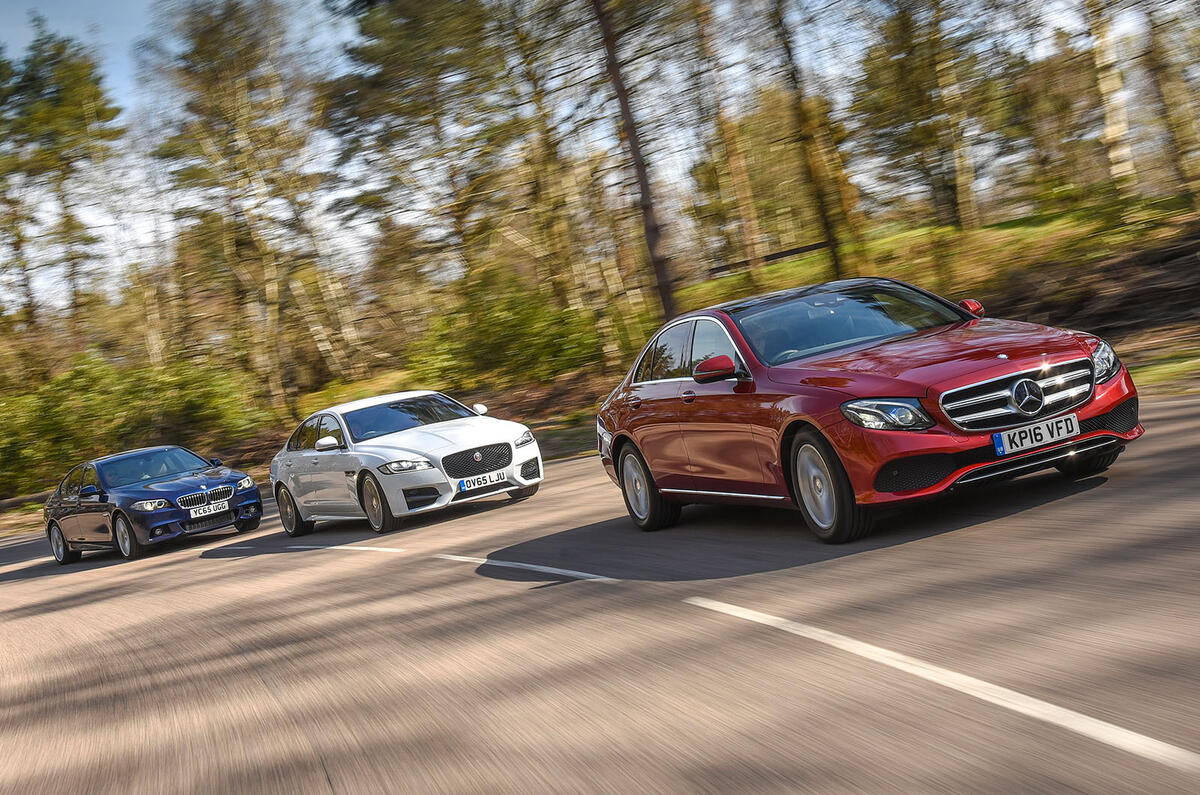
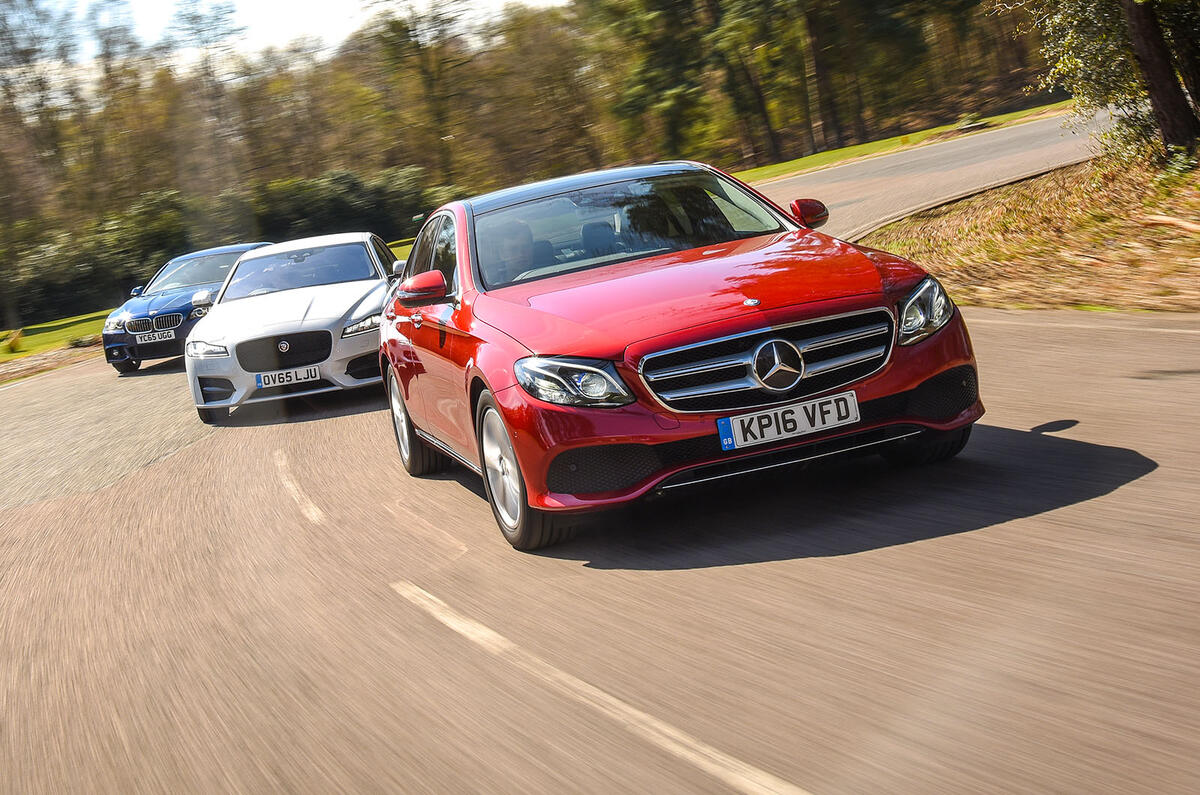
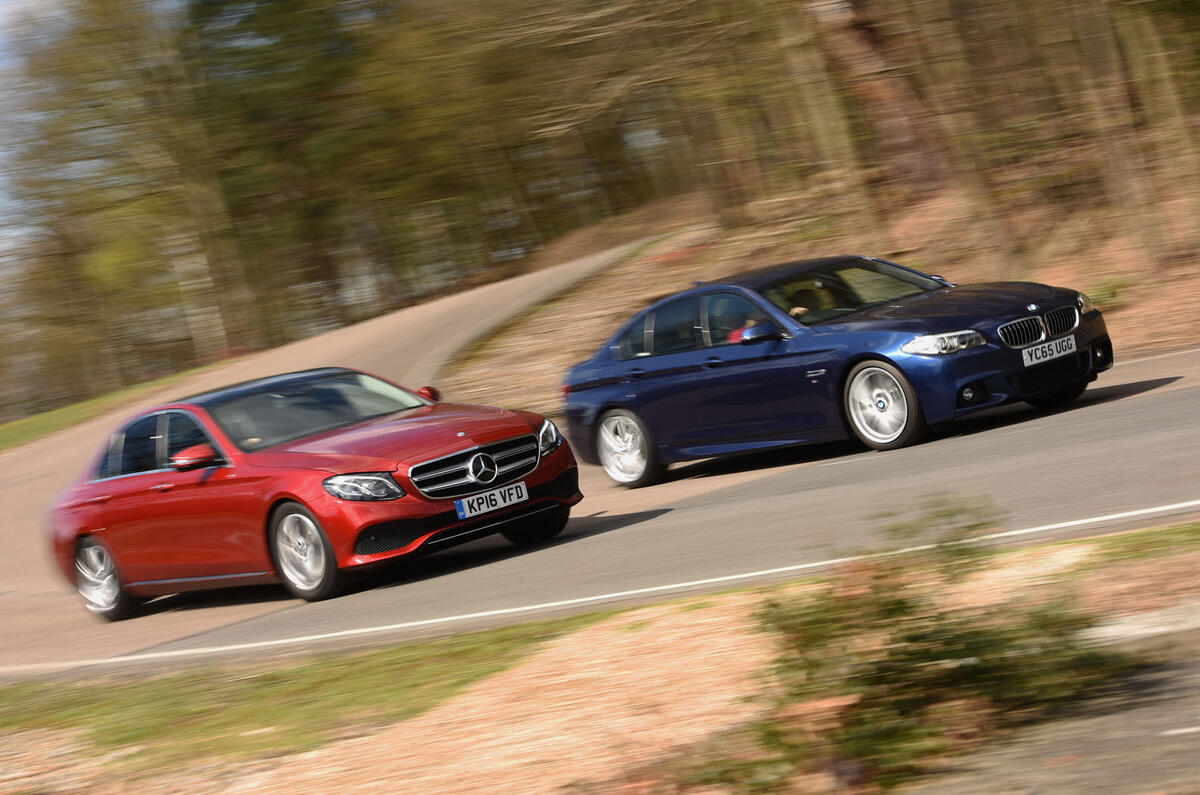
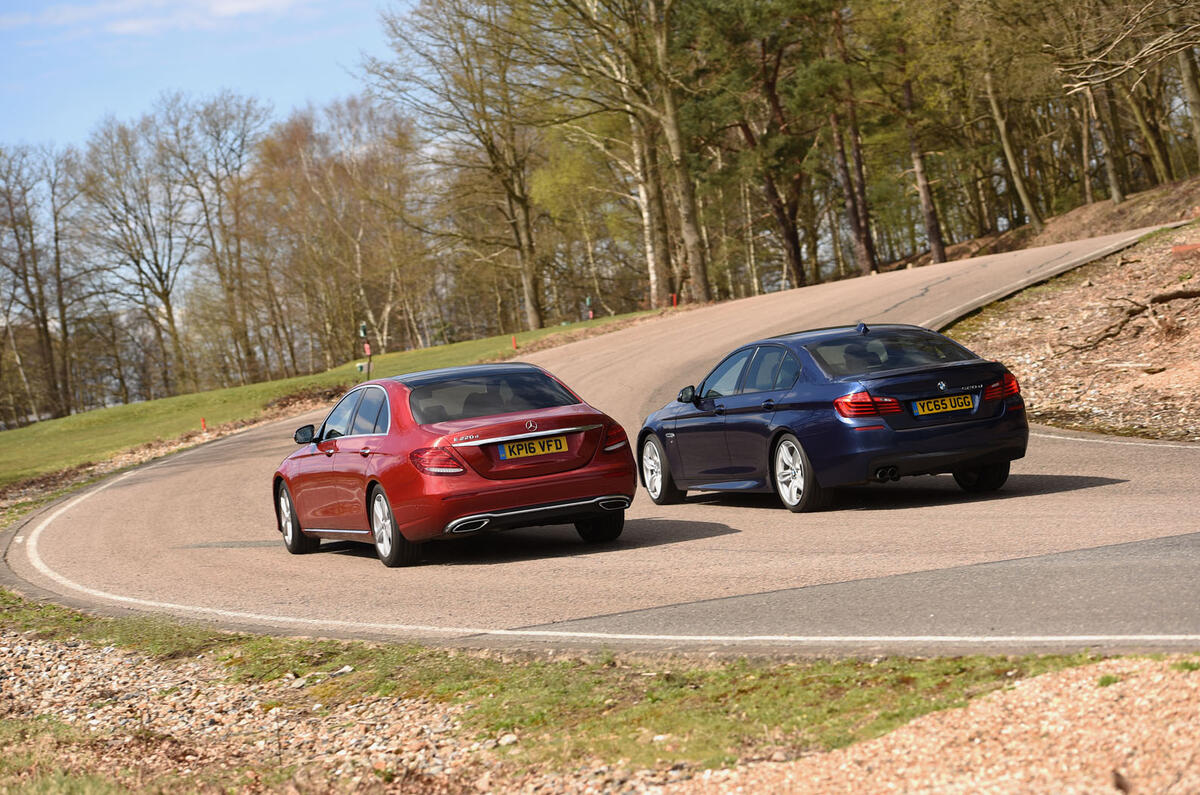
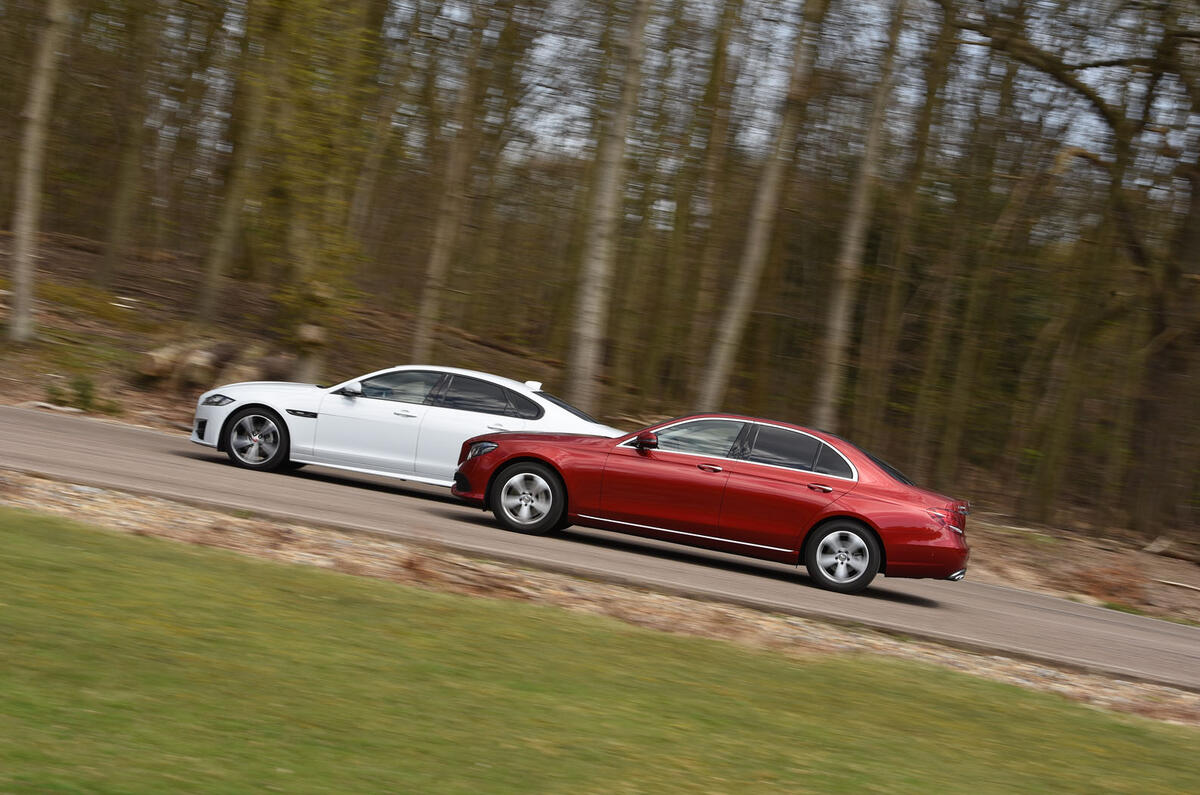
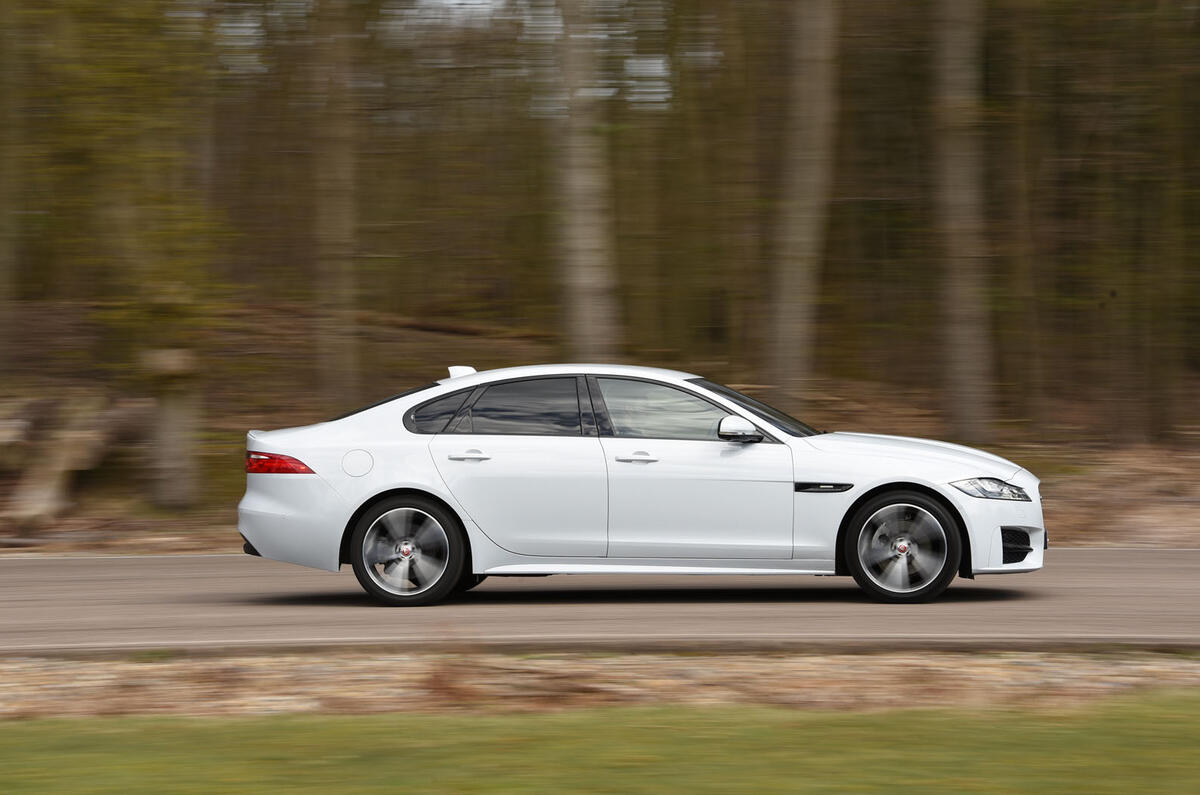
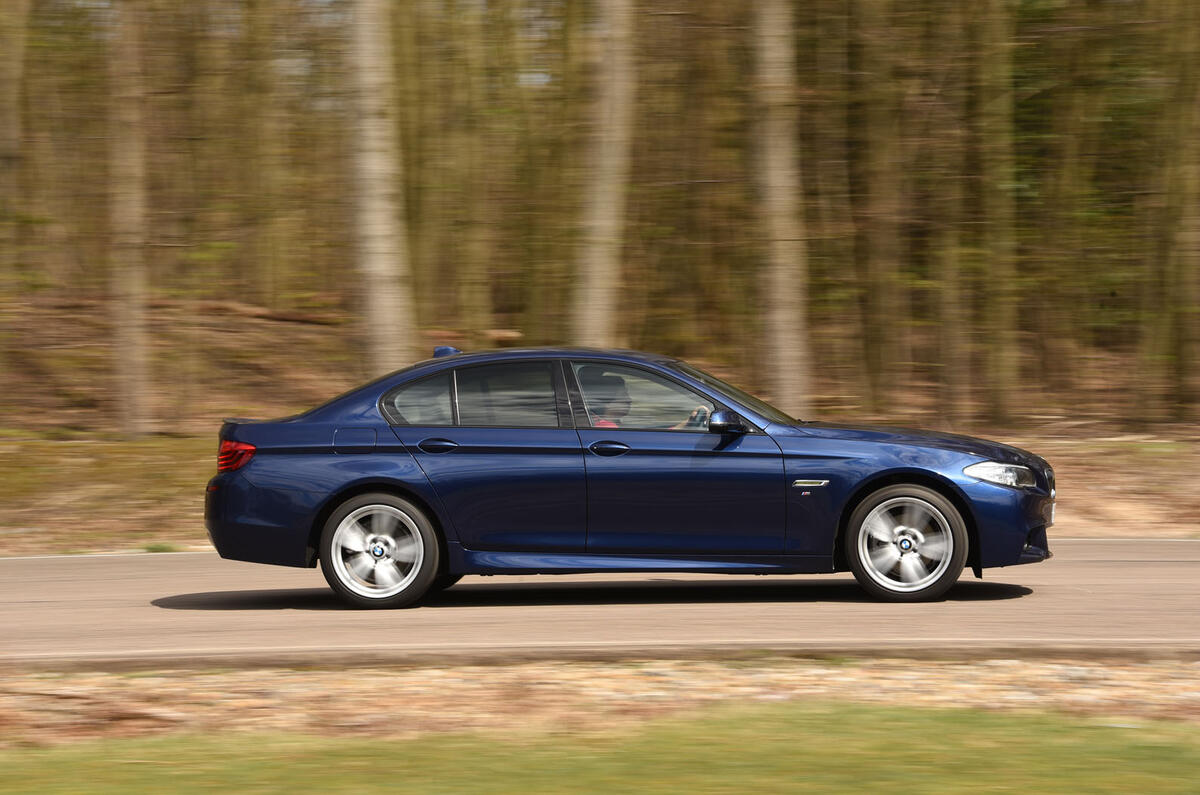
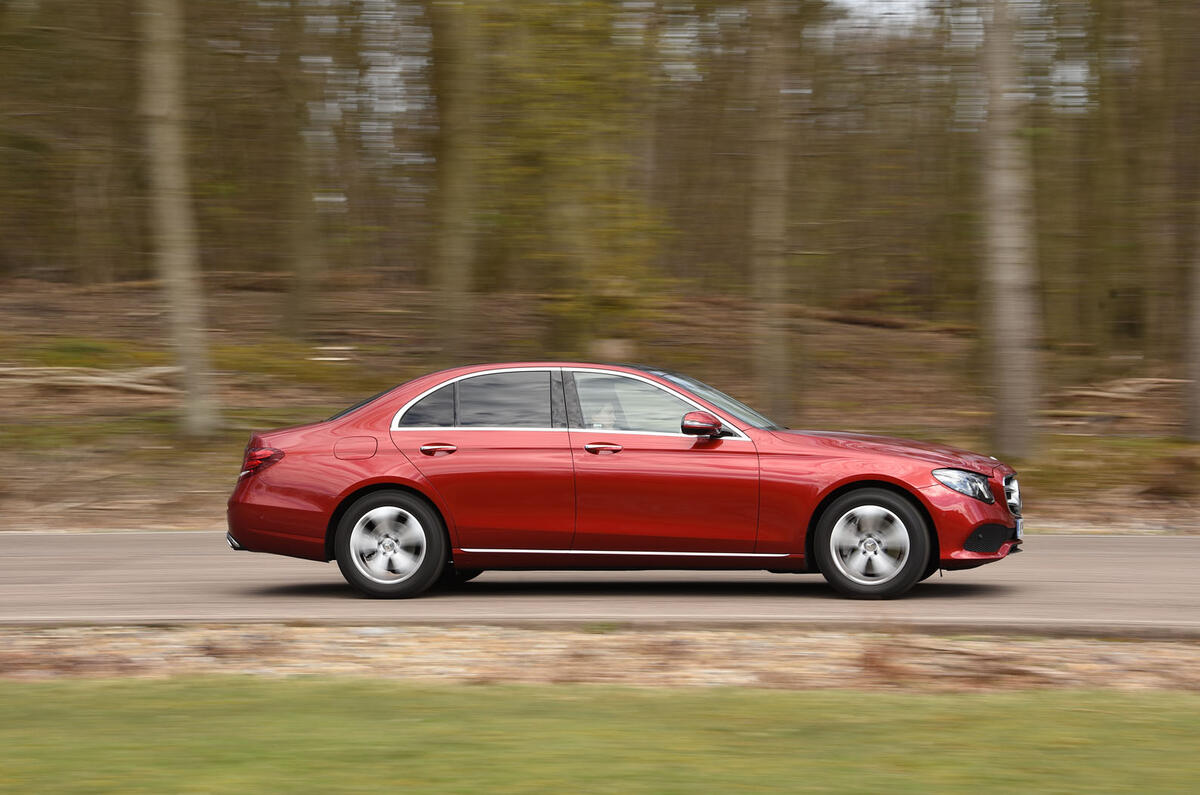
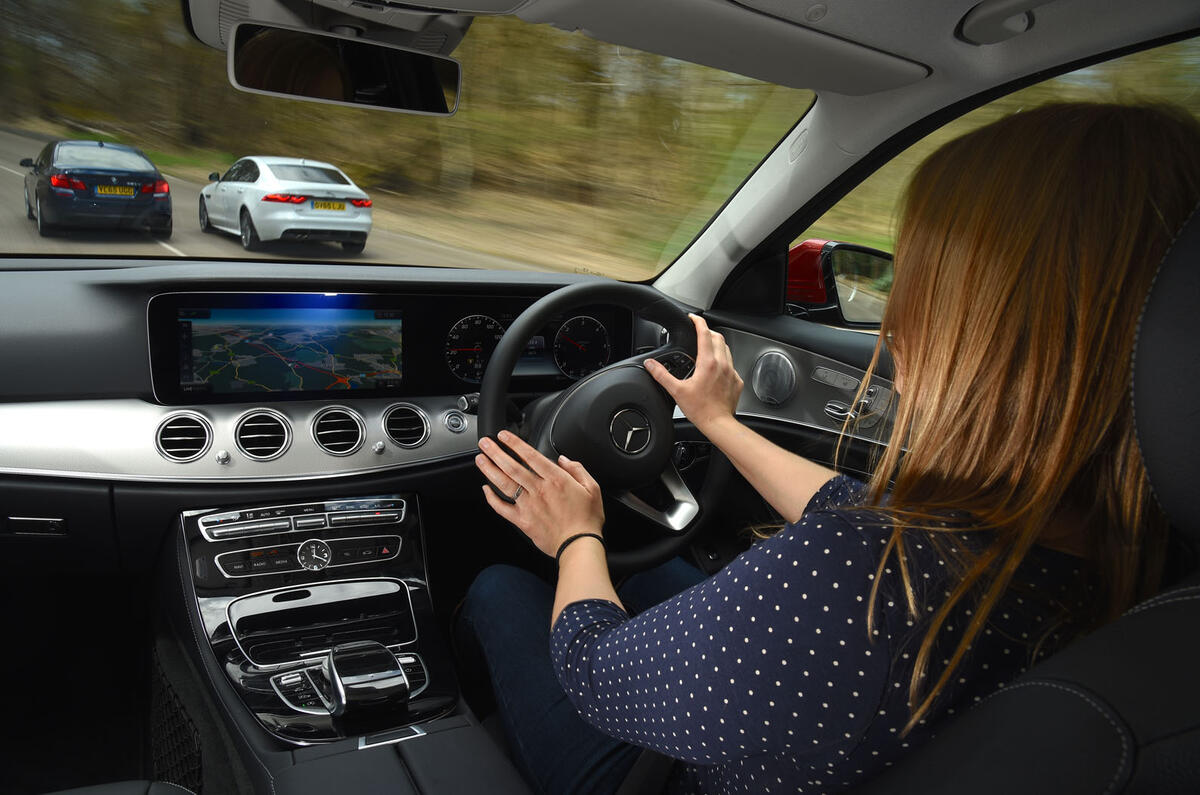
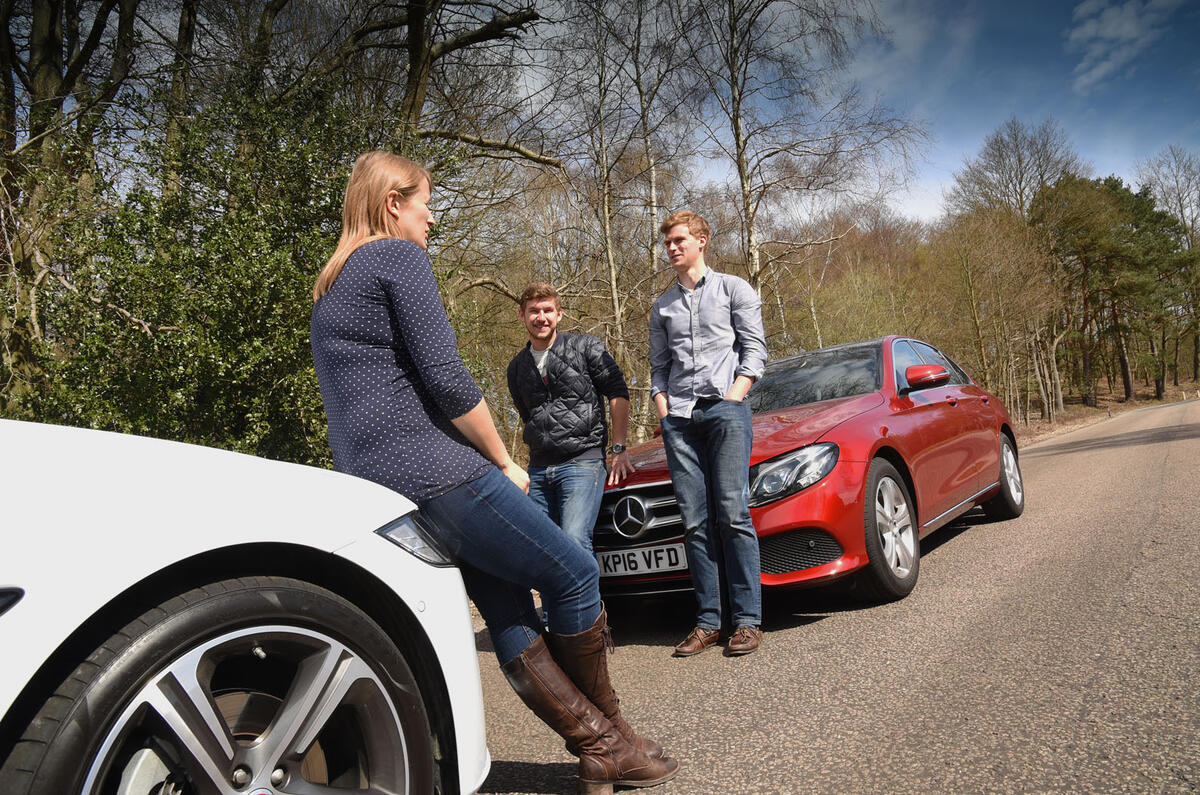
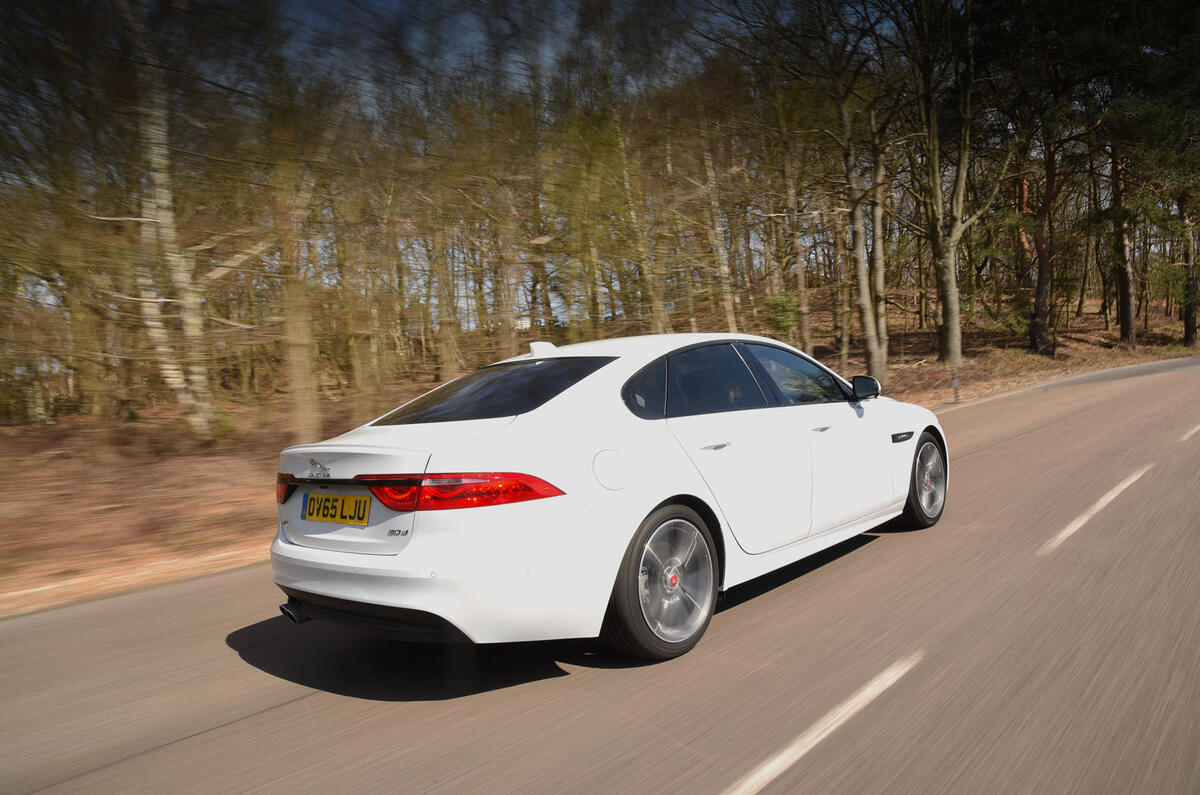
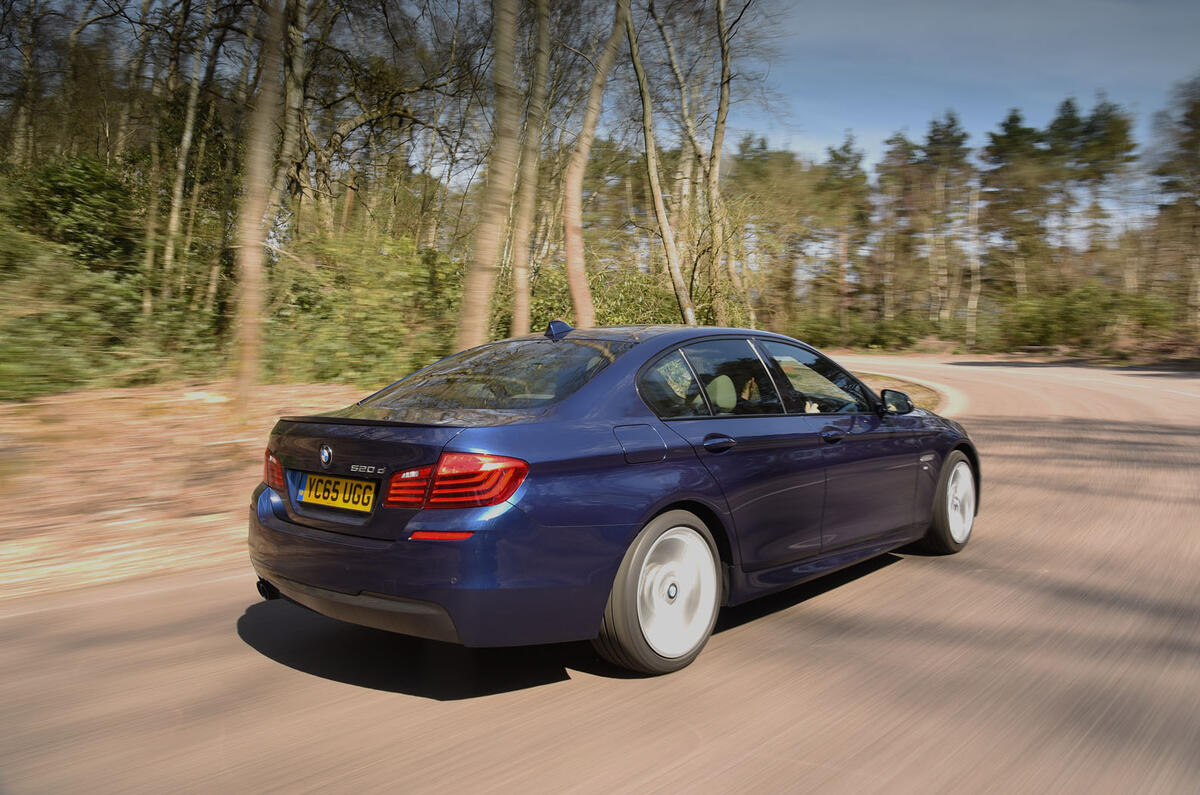
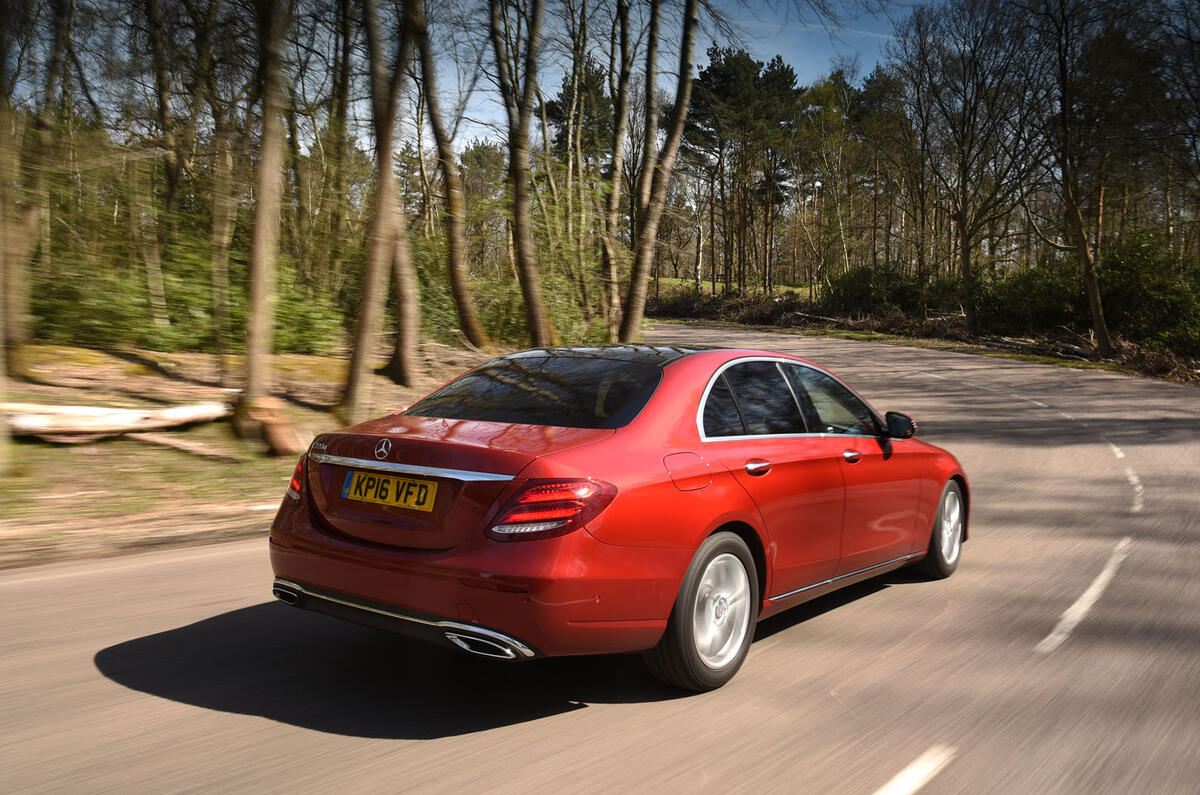


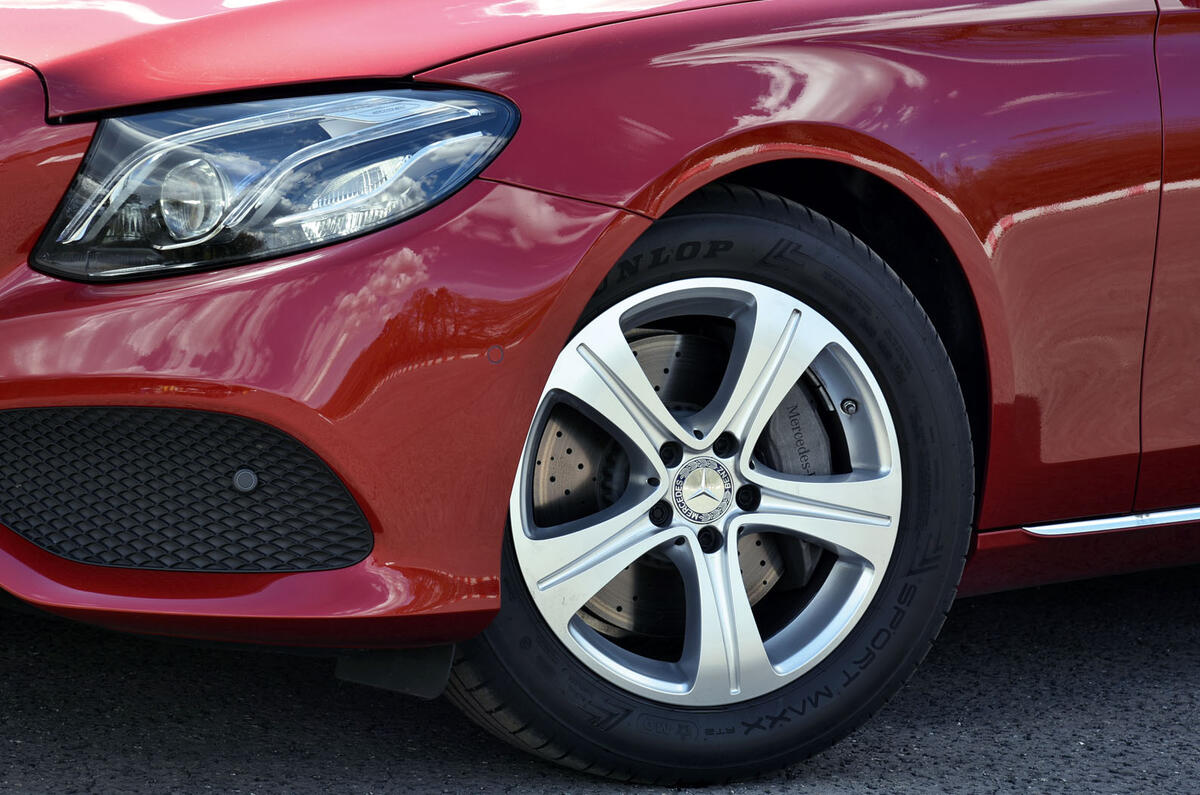

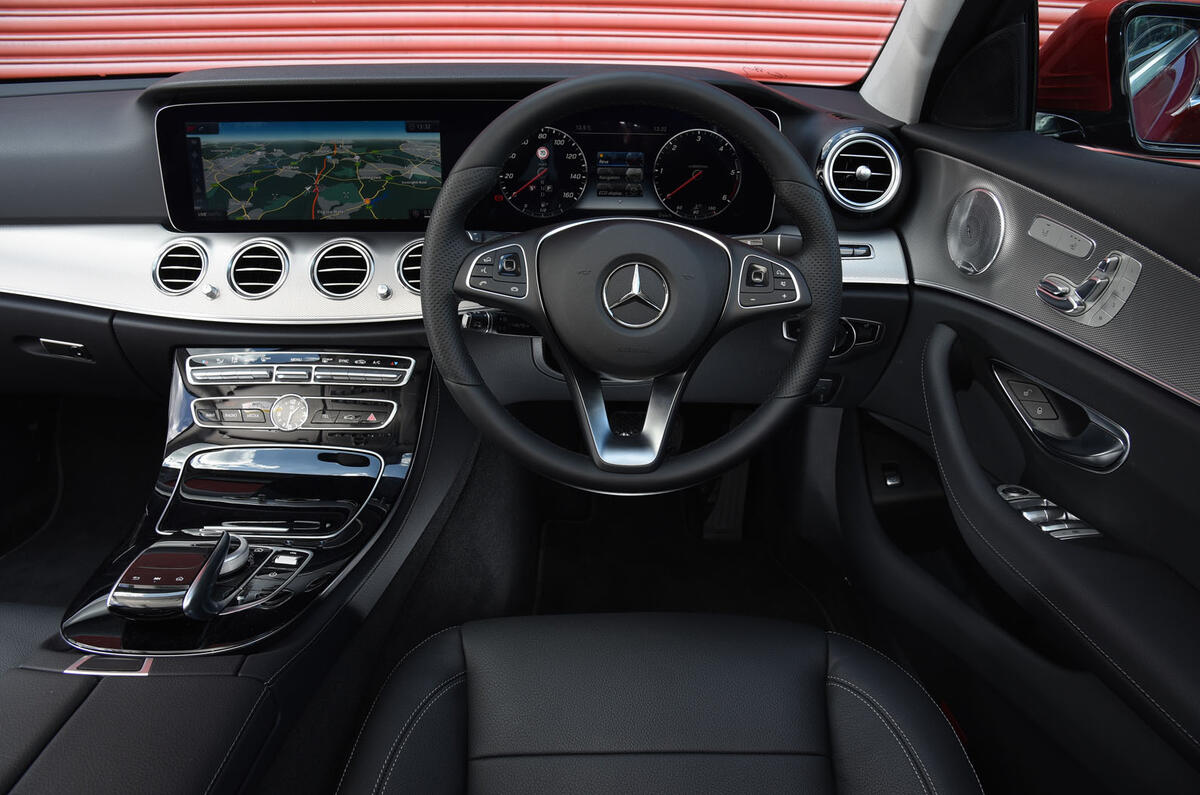
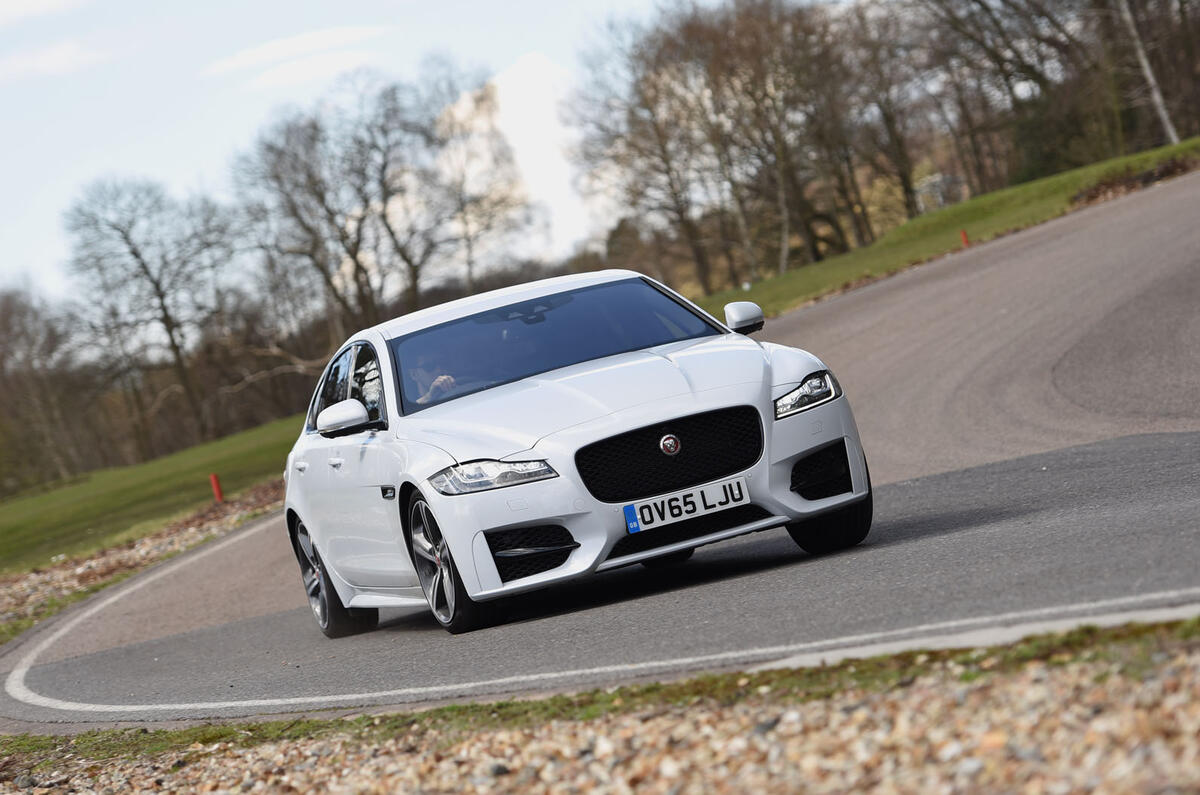

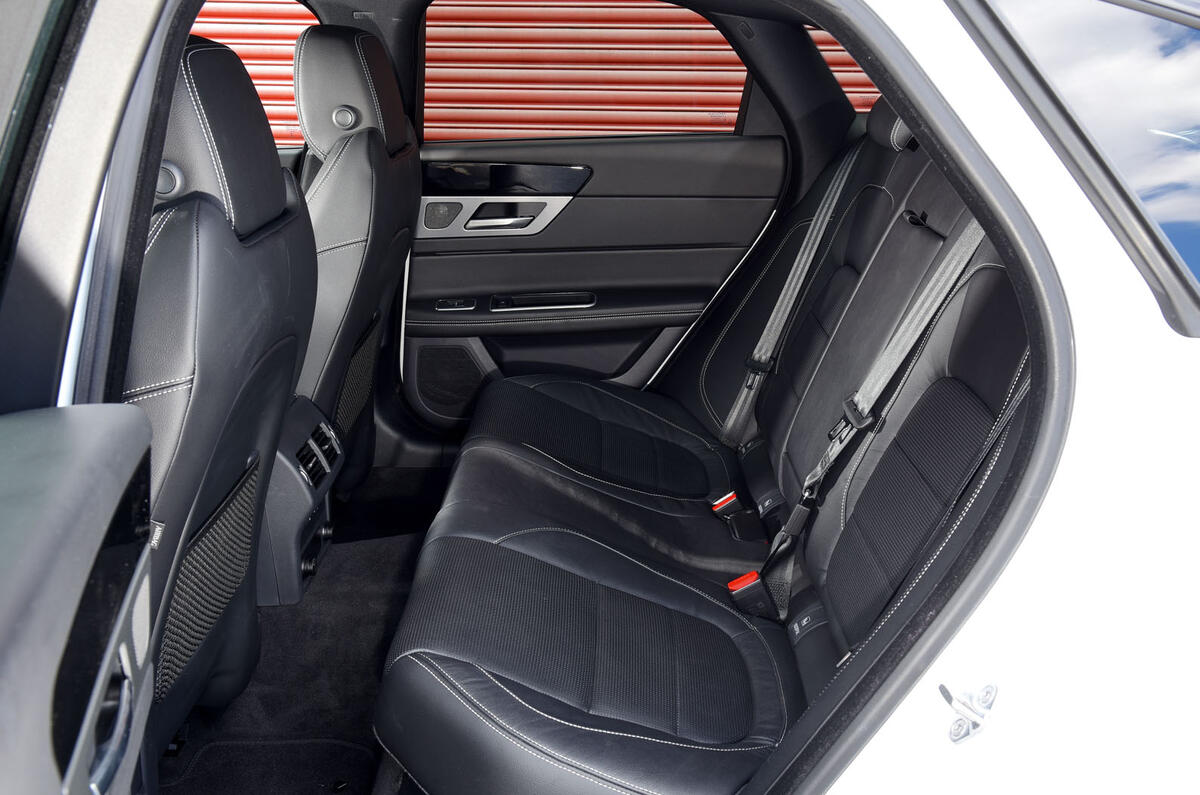
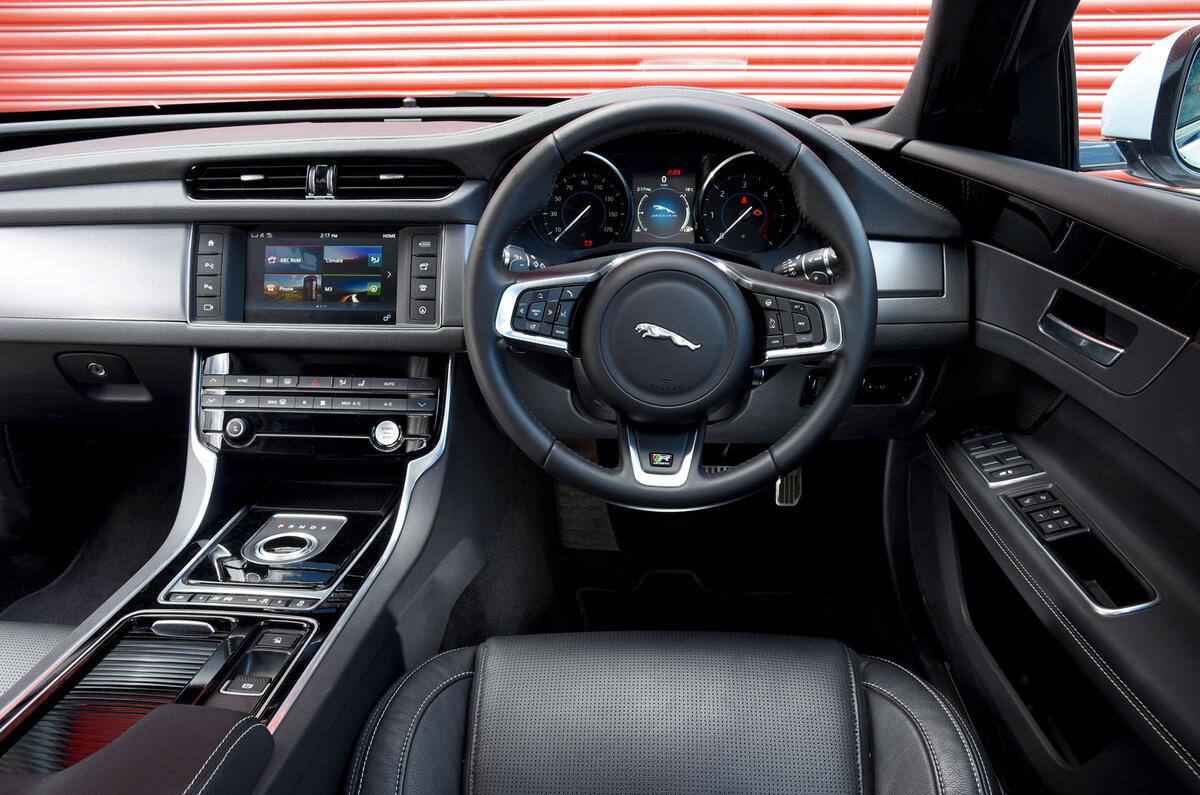
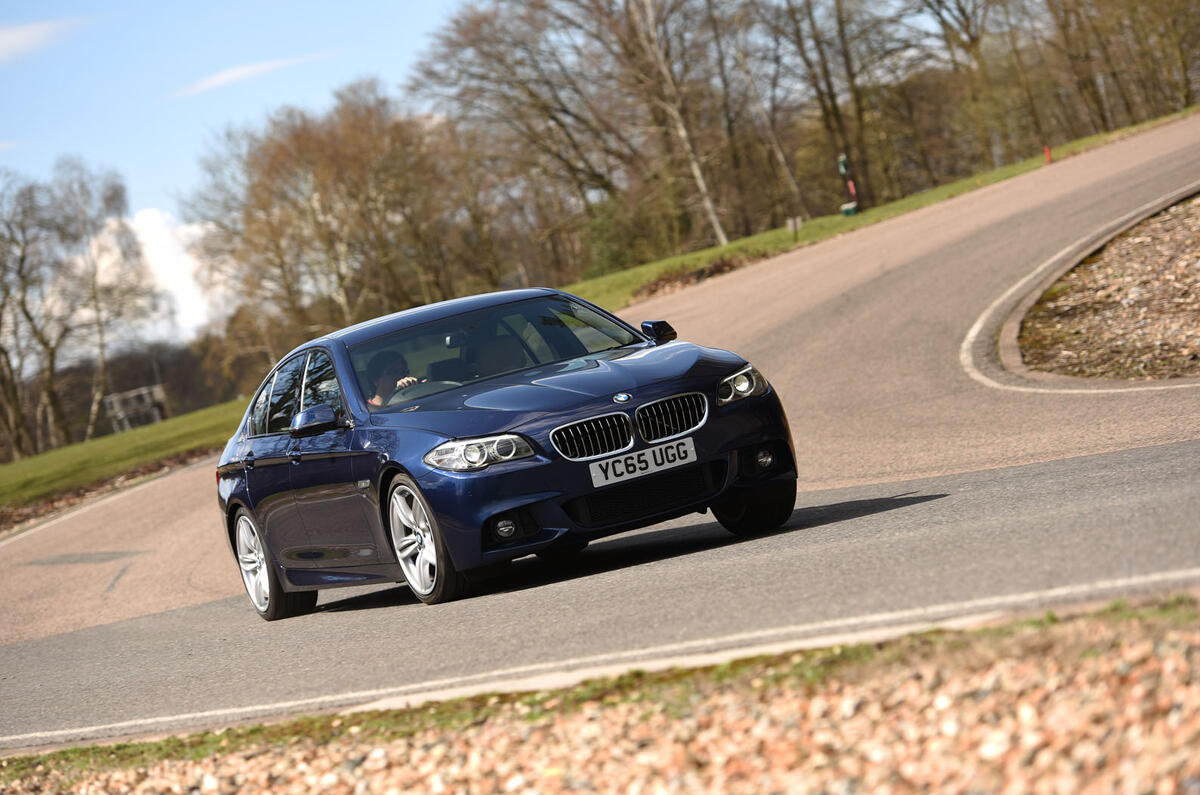
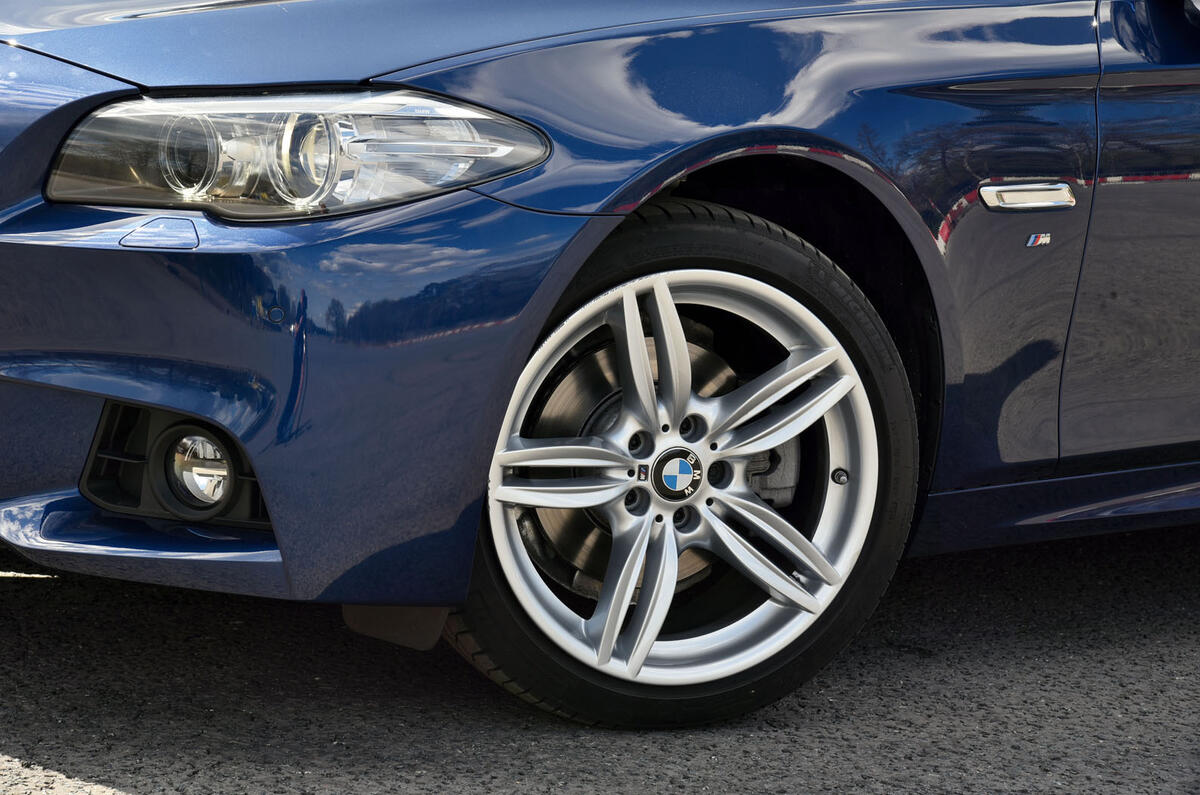
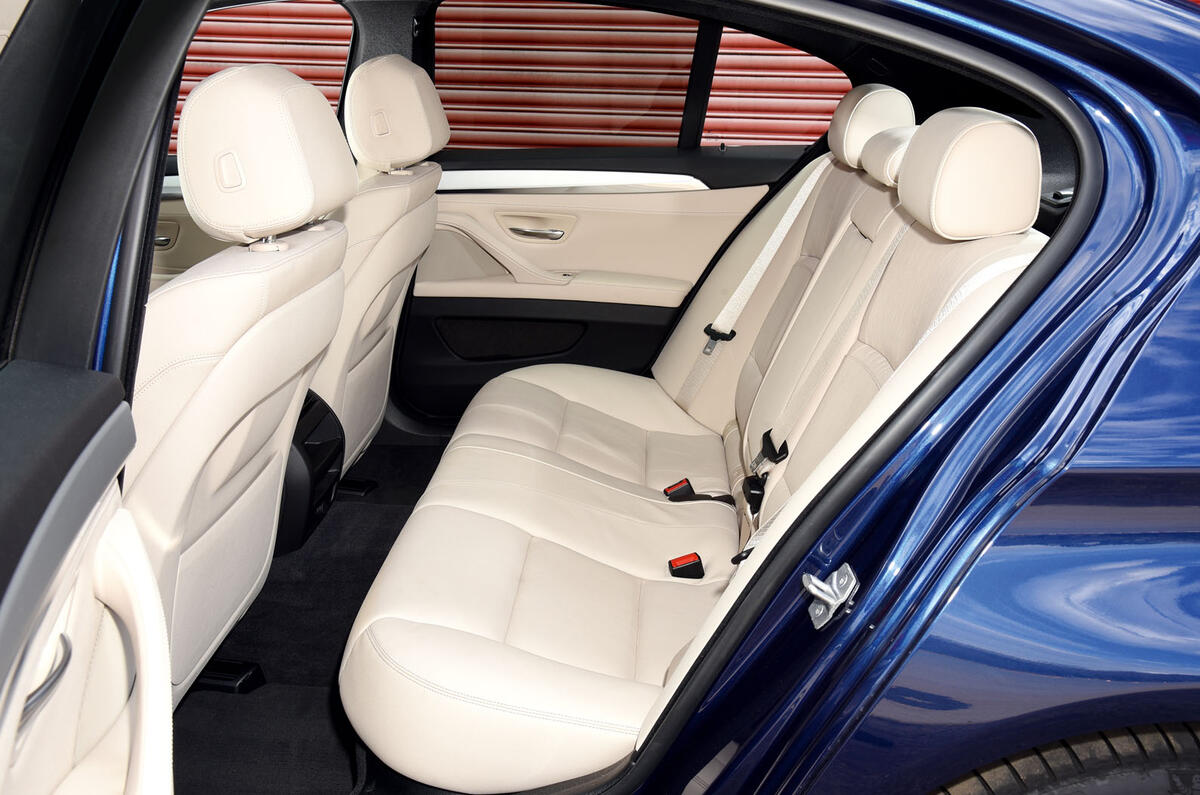
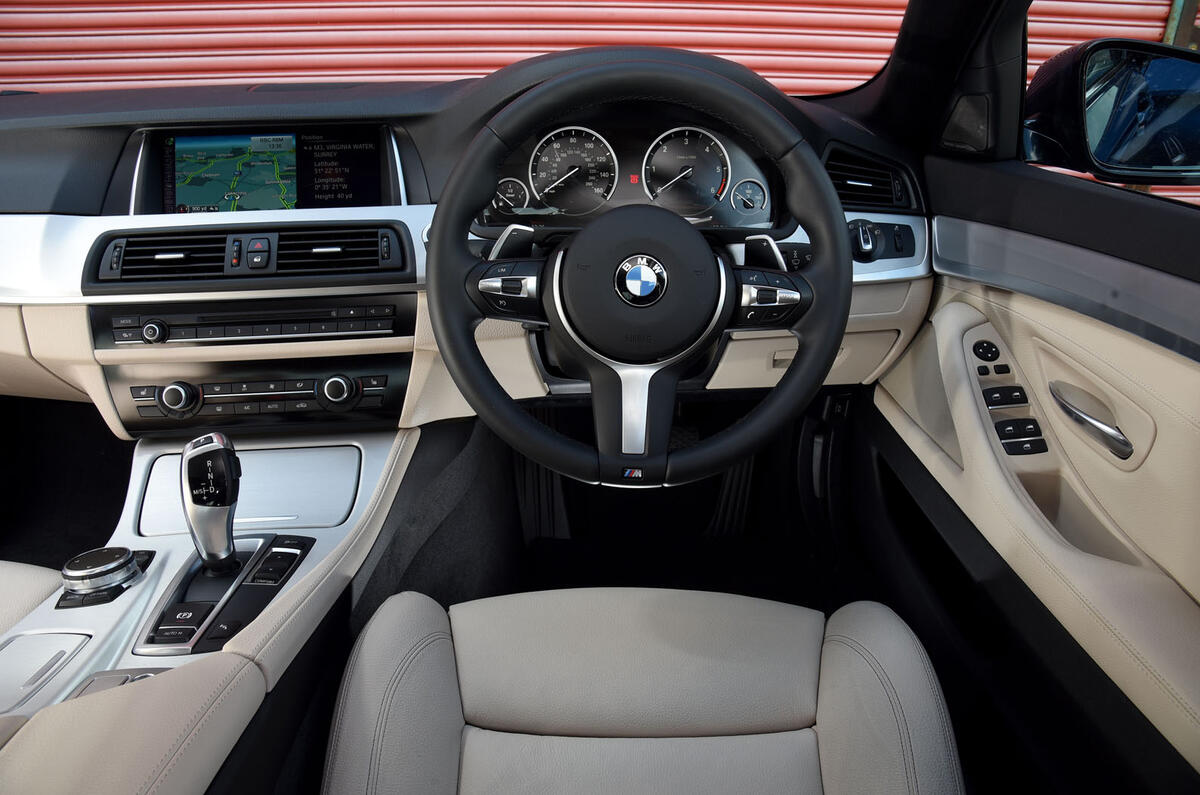
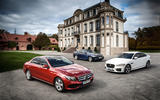
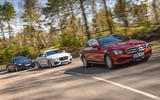
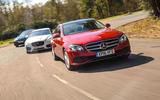
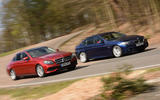
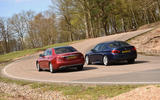
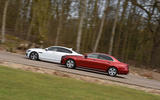
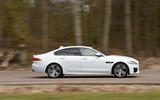
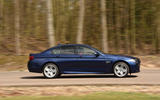
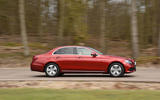
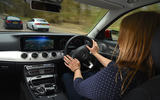
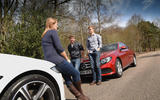
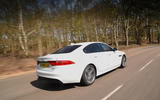
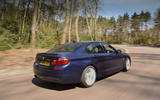
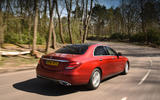
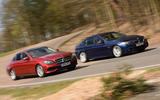
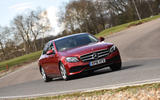
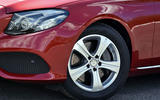
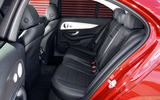
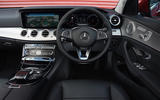
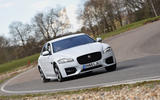
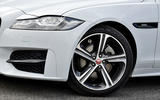
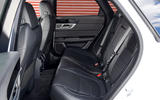
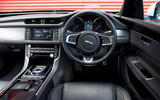

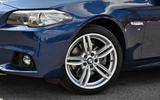
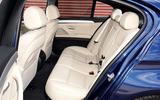
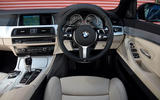






Join the debate
Add your comment
How does it work at Autocar:?
@bowsersheepdog
I've been reading Autocar for decades, and have always valued their comments. I ordered God knows how many road test reprints over the years before the inter-web came along and read them from end to end, sometimes buying vehicles just on the back of their reviews. They were always spot on. But now we seem to be at the stage (with 'some' reviewers) that there's no point in reading the conclusion at the end of a test that includes a JLR product, because we all know what it's going to be - no matter what is written in the text of the review. And I imagine competing manufacturers baulking at the prospect of supplying up vehicles for comparison when they know the product of all their hard work is going to be the loser even before a key is turned.
Merc-y waters